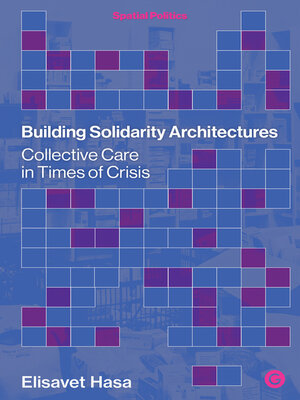Building Solidarity Architectures
ebook ∣ Collective Care in Times of Crisis · Spatial Politics
By Elisavet Hasa

Sign up to save your library
With an OverDrive account, you can save your favorite libraries for at-a-glance information about availability. Find out more about OverDrive accounts.
Find this title in Libby, the library reading app by OverDrive.



Search for a digital library with this title
Title found at these libraries:
| Library Name | Distance |
|---|---|
| Loading... |
On the spatial politics underlying the strategies of state abandonment in cities today.
Based on the foreground of a prolonged financial crisis, global pandemic, structural and racial violence, Building Solidarity Architectures examines how solidarity and decolonial movements are creating spaces of collective care, stepping in as providers of welfare services, and, in multiple contexts, acting as the first responders in support of disenfranchised communities. By defining state abandonment as a constantly resurging logic of withdrawing welfare services and deterioration of welfare infrastructures that predominantly affect the most marginalized groups, the book offers readers a lens to recognise forms of state abandonment in various localities and the potential collective responses to them. The book also delves into the materiality that results from this contestation and is therefore embedded in primary sources such as participant testimonies, activist texts, visuals, and images, to provide a rich and engaging account of what one could call a "lived architecture" of everyday practical, immediate, and coping mechanisms of collective care. It ultimately investigates how mutual aid and solidarity can also function as a material resource that counteracts the materiality of abandonment resurfacing in times of crisis. By exploring solidarity as a way of life, Building Solidarity Architectures helps us envision new places of liberation, reorganise the ways we live together, and reproduce the tools we have created for change to happen.
Based on the foreground of a prolonged financial crisis, global pandemic, structural and racial violence, Building Solidarity Architectures examines how solidarity and decolonial movements are creating spaces of collective care, stepping in as providers of welfare services, and, in multiple contexts, acting as the first responders in support of disenfranchised communities. By defining state abandonment as a constantly resurging logic of withdrawing welfare services and deterioration of welfare infrastructures that predominantly affect the most marginalized groups, the book offers readers a lens to recognise forms of state abandonment in various localities and the potential collective responses to them. The book also delves into the materiality that results from this contestation and is therefore embedded in primary sources such as participant testimonies, activist texts, visuals, and images, to provide a rich and engaging account of what one could call a "lived architecture" of everyday practical, immediate, and coping mechanisms of collective care. It ultimately investigates how mutual aid and solidarity can also function as a material resource that counteracts the materiality of abandonment resurfacing in times of crisis. By exploring solidarity as a way of life, Building Solidarity Architectures helps us envision new places of liberation, reorganise the ways we live together, and reproduce the tools we have created for change to happen.







